North Cascades
| North Cascades | |
|---|---|
| Canadian Cascades | |
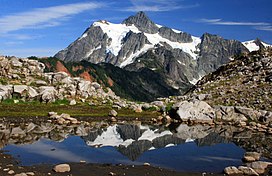 Mount Shuksan, one of the most picturesque peaks of the North Cascades | |
| Highest point | |
| Peak | Mount Baker |
| Elevation | 3,286 m (10,781 ft) |
| Dimensions | |
| Length | 434.5 km (270.0 mi) North-South |
| Width | 241 km (150 mi) East-West |
| Geography | |
| Countries | Canada and United States |
| Province/State | British Columbia and Washington |
| Parent range | Cascade Range |
| Borders on | Lillooet Ranges, Skagit Range |
The North Cascades are a section of the Cascade Range of western North America. They span the border between the Canadian province of British Columbia and the U.S. state of Washington and are officially named in the U.S. and Canada[1] as the Cascade Mountains.[2] The portion in Canada is known to Americans as the Canadian Cascades, a designation that also includes the mountains above the east bank of the Fraser Canyon as far north as the town of Lytton, at the confluence of the Thompson and Fraser Rivers.
They are predominantly non-volcanic, but include the stratovolcanoes Mount Baker, Glacier Peak and Coquihalla Mountain, which are part of the Cascade Volcanic Arc.
Geography
The U.S. section of the North Cascades and the adjoining
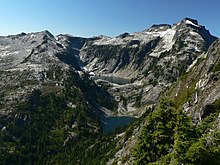
The large amount of
The eastern and northernmost parts of the range are much more plateau-like in character, though in the case of the northernmost areas graven by deep valleys along the flank of the Fraser Canyon, notably that of the Anderson River.
Extent
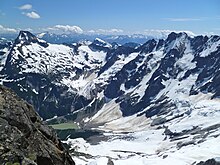
The
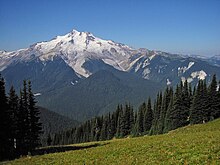
The southern boundary of the North Cascades is less definite. For the purposes of this article, it will be taken as
Geologically, the rocks of the North Cascades extend south beyond Stevens Pass and west into the San Juan Islands. The significance of the geologic transitions to the Okanagan Highland to the east and the Interior Plateau and Coast Mountains to the north are less agreed upon.[7]
Climate
The
The eastern slopes and mountain passes can receive significant snowfall. Cold Arctic air can flow south from
Subranges
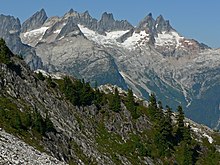
- North Cascades
- Skagit Range
- Chuckanut Mountains
- Entiat Mountains
- Chelan Mountains
- Methow Mountains (also called Sawtooth Ridge)
- Skagit River Group

- Canadian Cascades
- Skagit Range
- Hozameen Range
- Okanagan Range
- Coquihalla Range (name is unofficial)
- Llamoid Group (name is unofficial)
- Anderson River Group (name is unofficial)
Notable peaks
The following North Cascades peaks are notable for their height (absolute elevation):
| Mountain | Height | Coordinates | Prominence | Parent mountain | First ascent | ||
|---|---|---|---|---|---|---|---|
| (ft) | (m) | (ft) | (m) | ||||
| Mount Baker | 10,778 | 3,285 | 48°46′N 121°48′W / 48.767°N 121.800°W | 8,881 | 2,707 | Mount Rainier | 1868 by Edmund T. Coleman and party |
| Glacier Peak | 10,541 | 3,213 | 48°6′45.05″N 121°6′49.70″W / 48.1125139°N 121.1138056°W | 7,501 | 2,286 | Mount Rainier | 1898 by Thomas Gerdine |
| Bonanza Peak | 9,511 | 2,899 | 48°14′16″N 120°51′58″W / 48.23778°N 120.86611°W | 3,711 | 1,131 | Glacier Peak | 1937 by Curtis James, Barrie James, Joe Leuthold |
| Mount Fernow | 9,249 | 2,819 | 48°09′44″N 120°48′30″W / 48.16222°N 120.80833°W | 2,809 | 856 | Bonanza Peak | 1932 by Oscar Pennington, Hermann Ulrichs |
| Goode Mountain | 9,220 | 2,810 | 48°28′58″N 120°54′39″W / 48.48278°N 120.91083°W | 3,800 | 1,200 | Bonanza Peak | 1936 by Wolf Bauer, Philip Dickett, Joe Halwax, Jack Hossack, George MacGowan |
(The above table uses a topographic prominence cutoff of 1,000 feet (300 m), in order to list only highly independent peaks.)

The following peaks are notable for their topographic prominence:
| Mountain | Height | Prominence | Parent mountain | ||
|---|---|---|---|---|---|
| (ft) | (m) | (ft) | (m) | ||
| Mount Baker | 10,778 | 3,285 | 8,881 | 2,707 | Mount Rainier |
| Glacier Peak | 10,541 | 3,213 | 7,501 | 2,286 | Mount Rainier |
| Round Mountain | 5,320 | 1,620 | 4,780 | 1,460 | Three Fingers |
| Mount Spickard | 8,979 | 2,737 | 4,779 | 1,457 | Mount Baker |
| Welch Peak | 7,976 | 2,431 | 4,728 | 1,441 | Robinson Mountain |
| Three Fingers | 6,850 | 2,090 | 4,490 | 1,370 | Glacier Peak |
| Mount Shuksan[12] | 9,131 | 2,783 | 4,411 | 1,344 | Mount Baker |
| Remmel Mountain | 8,684 | 2,647 | 4,370 | 1,330 | Mount Lago |
| Mount Prophet | 7,650 | 2,330 | 4,080 | 1,240 | Luna Peak |
| Mount Outram | 8,074 | 2,461 | 3,678 | 1,121 | Hozomeen Mountain |
| Mount Lago | 8,743 | 2,665 | 3,300 | 1,000 | Silver Star Mountain |
The following peaks are notable for their large, steep rise above local terrain. Peaks are listed in descending order by elevation.
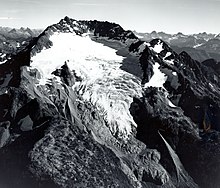

| Mountain | Height | |
|---|---|---|
| (ft) | (m) | |
| Mount Baker | 10,778 | 3,285 |
| Glacier Peak | 10,541 | 3,213 |
| Goode Mountain | 9,220 | 2,810 |
| Mount Shuksan | 9,127 | 2,782 |
| Jack Mountain | 9,066 | 2,763 |
| North Gardner Mountain | 8,956 | 2,730 |
| Mount Redoubt | 8,956 | 2,730 |
| Eldorado Peak | 8,876 | 2,705 |
| Luna Peak | 8,311 | 2,533 |
| Johannesburg Mountain | 8,220 | 2,510 |
| Agnes Mountain | 8,115 | 2,473 |
| Hozomeen Mountain | 8,066 | 2,459 |
| Slesse Mountain | 8,002 | 2,439 |
| American Border Peak | 7,994 | 2,437 |
| Mount Blum | 7,680 | 2,340 |
| Sloan Peak | 7,835 | 2,388 |
| Colonial Peak | 7,771 | 2,369 |
| Mount Triumph | 7,270 | 2,220 |
Pugh Mountain
|
7,201 | 2,195 |
| Davis Peak | 7,051 | 2,149 |
| Whitehorse Mountain | 6,850 | 2,090 |
| Baring Mountain | 6,125 | 1,867 |
Highest waterfalls
The North Cascades are known for having many extremely tall glacial-fed waterfalls; the ten highest measured waterfalls are listed.[13]
Many tall waterfalls occur where meltwater from mountain glaciers drop down a
Geology
The bulk of the North Cascades consists of "deformed and
Since about 35 million years ago,

Rocks similar to those in the North Cascades continue north to the vicinity of Mount Meager massif in the Coast Mountains, where they abut the Stikinia Terrane of the Omineca-Intermontane Province that dominates the Interior Plateau of British Columbia. This geologic similarity between the North Cascades and Coast Mountains results in a fairly arbitrary boundary between the two.
In British Columbia, the western geologic boundary of the North Cascades is defined as the
The eastern geologic boundary of the North Cascades may be marked by the Chewack-Pasayten Fault. This fault separates the easternmost portion of the North Cascades, the Methow Terrane, from the Quesnellia Terrane, one of the
The southern limit of what is geologically considered the "North Cascades" may variously be defined as being the southern limit of exposure of igneous and metamorphic terranes which is generally north of Snoqualmie Pass, Snoqualmie Pass itself, or Naches Pass at the White River Fault Zone.[7][19]
Glaciers
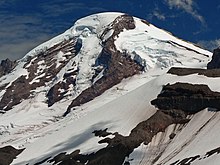
While
The Cascades north of Snoqualmie Pass have 756 glaciers covering 103 square miles (270 km2) of terrain. For comparison, the entire contiguous United States has about 1,100 glaciers in total, covering 205 square miles (530 km2).[22]
Ecology
The North Cascades has a diversity of plant species.
The range also has a rich diversity of animals, including
The biodiversity of the area is threatened by
History

On the United States side of the border, early inhabitants of the North Cascades included the

Miners dominated the exploration and development of the range from the 1880s through the early 20th century. For example, mines around the boomtown of
Early settlers also arrived in the foothills of the North Cascades in the latter half of the 19th century, and utilized the range in a limited way as a source of timber and grazing land. However, the range is so rugged that this exploitation was less dramatic than in other more gentle landscapes.
Early recreational use of the range included expeditions by the local
Climbing
The North Cascades are often referred as the "American Alps" by hikers, climbers and mountaineers because of the sea of steep, jagged peaks that span across the range. This range's rugged approaches and exceptional alpine terrain make it a premiere training ground for mountain climbers.[32]
Protected areas
Chief among the protected areas in Washington is
- Mount Baker Wilderness
- Glacier Peak Wilderness
- Boulder River Wilderness
- Henry M. Jackson Wilderness,
- Lake Chelan-Sawtooth Wilderness
- Noisy-Diobsud Wilderness
- Pasayten Wilderness
- Stephen Mather Wilderness
- Wild Sky Wilderness
In British Columbia, protected areas include
- Skagit Valley Provincial Park
- E.C. Manning Provincial Park
- Cascade Recreation Area
- Cathedral Provincial Park
- Sx̱ótsaqel/Chilliwack Lake Provincial Park
- Coquihalla Canyon Provincial Park
- Coquihalla Summit Recreation Area
See also
Notes
- ^ Government of Canada, Natural Resources Canada. "Place names - Search Results". rncan.gc.ca. Retrieved April 11, 2018.
- ^ "Cascade Mountains". BC Geographical Names.
- ^ Beckey 2000, p. 18
- ^ "North Cascades". Peakbagger.com. Retrieved September 17, 2010.
- Archive-It, U.S. Environmental Protection Agency, Western Ecology Division
- ^ Beckey 2003b, pp. 7–8
- ^ ISBN 0-07-048018-4.
- ^ "Thunderstorms light up the skies over Puget Sound". KOMO News, Fisher Communications. 2012.
- ^ Mathews 1988, pp. 557–562
- ^ Beckey 1996, p. 12
- ISBN 978-0-295-98847-4.
- ^ "Mount Shuksan, Washington". Peakbagger.com. Retrieved September 16, 2010.
- ^ "Showing All Waterfalls In Washington". Bryan Swan and Dean Goss. World Waterfall Database. Retrieved May 19, 2009.
- ^ Beckey 1987, p. 17
- ^ Beckey 1996, p. 10
- ^ a b "North Cascades National Park Geology: A Mountain Mosaic". United States Geological Survey. Archived from the original on June 12, 2018. Retrieved June 9, 2009.
- ^ Mathews 1988, pp. 519–520
- ^ Mathews 1988, p. 522
- ^ "Geologic maps and databases of the North Cascades 30' x 60' (1:100,000 scale) quadrangles". United States Geological Survey. Archived from the original on May 12, 2009. Retrieved June 9, 2009.
- ^ Doughton, Sandi. "'Disastrous': Low Snow, Heat Eat Away at Northwest Glaciers." The Seattle Times. Seattle Times, 08 Sept. 2015. Web. 15 Dec. 2015. <http://www.seattletimes.com/seattle-news/science/disastrous-low-snow-heat-eat-away-at-northwest-glaciers/>.
- ^ Mauri, Pelto. "Death of a Glacier". North Cascade Glacier Climate Project. Archived from the original on September 29, 2008. Retrieved October 24, 2008.
- ^ Beckey 2003a, p. 13
- ^ a b c Kefauver, Karen (September 15, 2010). "North Cascades National Park: Wildlife". GORP. Orbitz. Archived from the original on April 27, 2012. Retrieved June 6, 2012.
- ^ a b c d "Plants". North Cascades National Park. National Park Service. May 16, 2012. Retrieved June 6, 2012.
- ISBN 0-295-97477-X.
- ^ Rawhouser, Ashley K.; Holmes, Ronald E.; Glesne, Reed S. (2009). "A Survey of Stream Amphibian Species Composition and Distribution in the North Cascades National Park Service Complex, Washington State" (PDF). Archived from the original (PDF) on October 16, 2011.
- ^ "Non-native plants". North Cascades National Park. National Park Service. Retrieved June 6, 2012.
- ^ Beckey 1996, p. 141
- ^ Beckey 1996, p. 203
- ^ Beckey 1996, p. 27
- ^ Beckey 1996, p. 140
- ^ "Mountain Climbing". Mt. Baker-Snoqualmie National Forest. U.S. Forest Service. Retrieved February 15, 2014.
References
- ISBN 0-89886-152-7.
- ISBN 0-89886-152-7.
- ISBN 0-89886-152-7.
- ISBN 978-0-89886-577-6.
- ISBN 0-89886-423-2.
- ISBN 0-87595-243-7.
- Mathews, Daniel (1988). Cascade Olympic Natural History: A Trailside Reference. Raven Editions. ISBN 0-9620782-1-2.
External links
- Official website, including the Ross Lake and Lake Chelan National Recreation Areas

